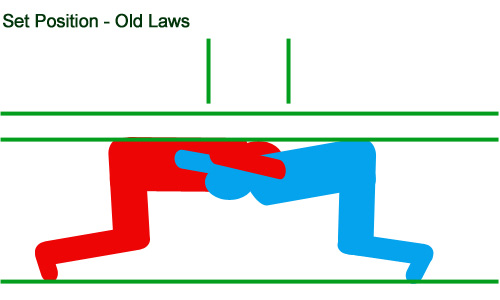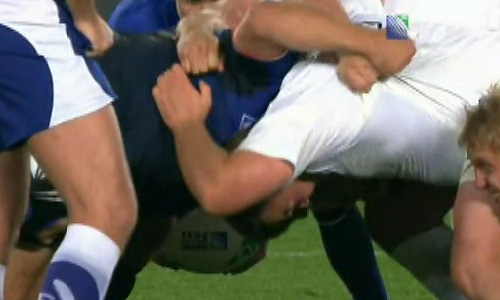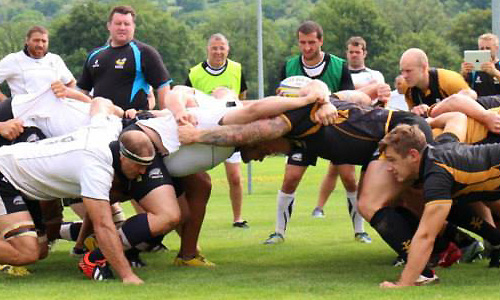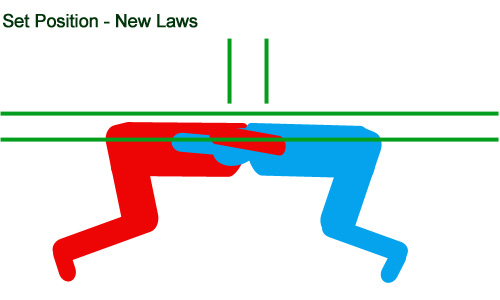Whether Benn Robinson was omitted from the Wallabies squad based on his scrummaging or work around the park hasn’t been revealed.
But it may well be the new scrum laws have helped Ben Alexander and worked against Robinson.
There are three areas of change with the new (trial) scrum laws:
- Pre-set where props have to bind on to each other, which means they start closer together;
- Post-set where the scrum must be stationery and stable before the ball can be fed; and
- Post-set with the law requiring the ball to be fed in the middle of the tunnel to be enforced.
The changes reduce the importance of the ‘hit’ but have a much greater impact post-set. The delay while the scrum stabilises before the ball can be fed significantly changes how the scrum will work.
Scrummaging under the old laws
To understand how the changes will affect the scrum and how they will assist a prop like Alexander and disadvantage Robinson, we first need to look at how props packed under the old laws.
The aim of the best loosehead props was to get under their tighthead opponent as they set and to use that lower position to disrupt the tighthead by driving slightly upwards – it’s very hard for a prop who’s being lifted up to stop being driven backwards.
Yes, driving up is against the laws but this was the tactic used and was one of Robinson’s strengths.
The tighthead knew what the loosehead was trying to do, so their aim was to set lower to stop the loosehead getting under them.
The lower you can get your hips pre-set, the lower you can get on the set, but props have to keep their knees in front of their hips pre-set to maintain their balance as shown below.

The space between the props before they set allowed them to move their hips forward as they set. On the set the feet stayed in the same position, which allowed the knees to drop and in turn lowered the body height as shown below.
I’ve left the pre-set height and gap lines in for comparison.

Tightheads who set up high and were slow on the set got caught high and were easily destabilised as the loosehead got under them – this was one of Alexander’s biggest issues, primarily caused by setting up too high initially.
To try and counter this, Alexander often set up with his shoulders below his hips so he was angling down as he set, to try and make it harder for the loosehead to get under him.
He also often pulled his feet back pre-set in an attempt to get lower but this also caused him to angle down as he set causing collapses.
These ‘fixes’ are like a golfer aiming left to counter a slice – they don’t solve the real problem.
Scrummaging under the new laws
Under the new laws the main difference in set up position is that the props will start much closer together.
I don’t think we’ll see much difference in the pre-set height. It will look something like the following and I’ve left the starting gap lines under the old laws in for comparison.

Starting closer together means the props won’t have the space to move their hips as far forward as they set, so their knees will stay a little further in front of their hips and they won’t be able to pack as low as they used to.
The props can’t set up with their feet too far back to counter this as they won’t be able to maintain their balance pre-set.
The loosehead binds under the tighthead’s arm and under the old laws (particularly with little to bind on to with tight jerseys) the loosehead would often miss their bind as they set and go to ground or put their hand on the ground to stay up.
The new laws will eliminate many of the collapses due to missing the bind on the set, as the props must bind before they set.
If the loosehead packs under the tighthead they get into a very awkward position when they set as shown below.

Maintaining the bind while in that awkward position is very difficult as it’s hard to maintain any power in the grip when reaching up like this.
Under the old laws the loosehead got out of that awkward position by driving up as soon as they set to get their head back up into a better position. This lifted the tighthead up and destabilised them.
Under the new laws if the loosehead sets under the tighthead, as shown above, they can’t start driving as soon as they set so will have to stay down in that position while the scrum stabilises. The longer it takes for the scrum to stabilise the harder it will be to maintain the bind.
Don’t be surprised if teams take longer to stabilise to disadvantage looseheads who pack underneath the tighthead.
I don’t expect it will take long for looseheads to work out that setting under the tighthead is no longer the advantage it was under the old laws. They will then start setting closer to the height of the tighthead prop.
This will mean teams scrummage a little higher and, importantly, scrums will be a contest about pushing forward, not forward and up, as was the tactic under the old laws.
Here’s an example from a pre-season scrum session between Zebre and Wasps where you can see even though the Zebre tighthead on the left has got his hips lower than the Wasps’ loosehead pre-set, he is angling up to meet the pre-set shoulder height of the Wasps’ prop.

The body position and height after the set under the new laws will look something like I’ve shown below. I’ve left the line showing set height under the old laws and the line showing pre-set height in for comparison.

What this means for different players
These changes will help Alexander enormously, as he was rarely able to get low enough pre-set to match his loosehead opponent and was often destabilised by the loosehead getting under him.
He struggled as a loosehead himself because he couldn’t set low enough to get under his tighthead opponents and therefore couldn’t use the key advantage looseheads had under the old laws.
However, with this change Robinson will no longer be as effective.
The next area of significant change post-set is what happens to the momentum from the hit, even though it is greatly reduced.
As the scrum is now going to have to be stationary and stable before the ball can be fed, all of the momentum from the hit will dissipate and no longer be available to help a team drive over the ball.
Under the new laws the whole pack is going to have to generate momentum from a stationary position as the ball is fed and they’ll have to do it without the help of the hooker because they’ll be too busy striking for the ball to help.
This momentum will have to be generated through a very co-ordinated shove from seven members of the pack working as one. Even if a smaller prop has better technique and can resist being driven backwards, it’s unlikely he’ll be able to drive a bigger, heavier prop backwards without the momentum of the hit to help him as used to exist under the old laws so bigger, heavier props will have an advantage.
This is another benefit for Alexander and a disadvantage for Robinson.
It may be Robinson has been omitted from the Wallabies squad not just to go away and improve his work rate around the field but also to work on a scrum technique to help him adapt to the new laws.
Of course the final area post-set where the new laws will have a major impact is the ball being fed straight, which will bring back another contest that used to exist by giving hookers a chance to strike for the ball.
Many hookers will have to learn this skill for the first time but whether there is a true contest will rely on referees strictly enforcing the ball being fed into the middle of the tunnel.
I really hope they do.
These changes are good for the game
In summary, these changes don’t just reduce the force of the ‘hit’ – in fact they will have far more impact post-set.
After some collapses on the set in early matches whilst teams adapt, the number of scrums being completed without reset will lift significantly and the new laws will also encourage a genuine contest in the scrum, not one generated artificially through the hit, so the new laws are good for the game.



































































































